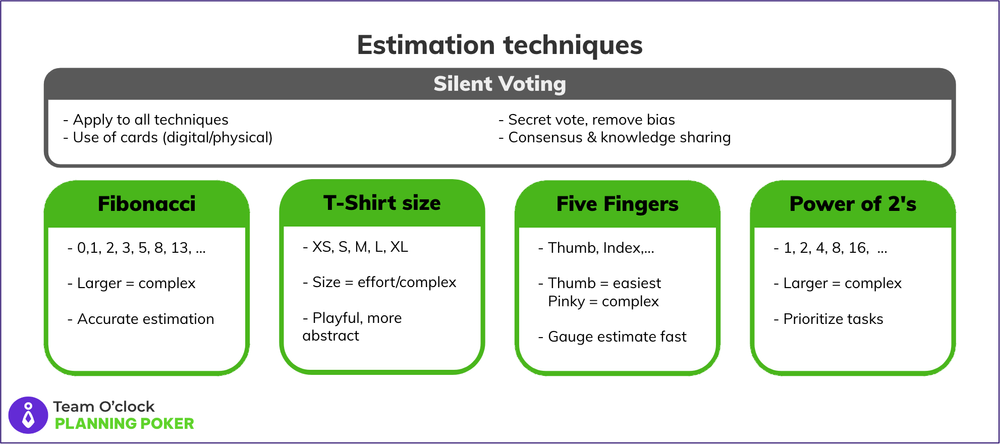
Agile Success Unveiled: How Estimation Techniques Enhance Planning Poker

At its core, Agile values collaboration, adaptability, and continuous improvement. Estimation is pivotal in the Agile process, enabling teams to plan, prioritize, and deliver work effectively. In this blog, you will discover how Agile estimation, combined with the powerful technique of Planning Poker, can be a game-changer for Agile teams.
Why Does Estimation Matter in SCRUM?
Estimation is the compass that guides Agile projects. Without accurate and reliable estimates, teams can be adrift in a sea of uncertainty. Estimation serves as the foundation for setting realistic expectations, making informed decisions, and meeting project objectives. Whether you follow SCRUM or any other Agile framework, estimation remains a fundamental element.
Working with Agile principles, change is inevitable, and projects often evolve as they progress. Estimation provides a way to gauge the size and complexity of tasks. This way, teams can make data-driven decisions on how to allocate resources, set priorities, and adapt to changing requirements.
5 Common Estimation Techniques in Planning Poker
Estimation is not a one-size-fits-all practice. Agile teams employ various techniques to estimate the size and effort required for tasks. Planning Poker harnesses the collective wisdom of the team to arrive at a consensus. Here are some popular estimation techniques used in Planning Poker:
1. Fibonacci Sequence
The Fibonacci sequence is a series of numbers, where each number is the sum of the two preceding ones, starting from 0 and 1. The sequence typically begins like this: 0, 1, 2, 3, 5, 8, 13, 21, 34, etc.
It's a straightforward way to express relative complexity. Team members choose a number representing their estimate for a task, and discussions continue until a consensus is reached.
Using the Fibonacci scale, Planning Poker acknowledges that as tasks get larger or more intricate, the degree of uncertainty and the potential for hidden complexities become greater, making it a practical tool for Agile teams to estimate and plan their work effectively. This approach encourages discussion, promotes team consensus, and results in more accurate task estimations.
2. T-shirt Sizing
This technique uses t-shirt sizes (XS, S, M, L, XL) to represent the relative effort required for a task. Here's how t-shirt sizing can be used in Agile planning, including Planning Poker:
Size Labels:
T-shirt sizing uses labels like XS (Extra Small), S (Small), M (Medium), L (Large), and XL (Extra Large) to represent the size or effort required for a task or user story.
Estimation Process:
In a typical Agile planning session, the team discusses a task or user story to be estimated.
Instead of using specific numerical values, team members assign a T-shirt size label that they believe represents the effort or complexity of the task. For example, if a task is relatively easy, they might assign it an "XS" size, while a more complex task might be labeled "L" or "XL."
Team members can also use other labels like "M" or "S" for tasks of moderate or small complexity, respectively.
Discussion and Consensus:
After assigning T-shirt sizes to tasks, team members discuss their choices. If there's a significant difference in the designated sizes, it prompts valuable discussions to reach a consensus on the effort required for each task.
3. Five Fingers
The 5-finger Estimation is a variation of Planning Poker that uses the fingers of one hand to represent estimation values, typically ranging from 1 (thumb) to 5 (little finger). Here's how the 5-Finger Estimation can be used in Planning Poker:
Value Assignments:
Each finger on the hand represents an estimation value, usually as follows:
Thumb (1) - The most minor or most straightforward task.
Index finger (2) - Slightly larger or more effort.
Middle finger (3) - A medium-sized task.
Ring finger (4) - A larger or more complex task.
Little finger (5) - The most significant or most challenging task.
Estimation Process:
In an Agile planning session, the team discusses a task or user story to be estimated.
Team members simultaneously show their estimation by raising the corresponding finger on one hand to indicate the perceived effort or complexity of the task.
Discussion and Consensus:
After the initial estimates are revealed, team members discuss the reasons for their estimations. If there's a significant difference in the raised fingers, it triggers discussions to reach a consensus on the effort required for each task.
Refinement:
Depending on the discussions and new insights, the team may revise their estimations by showing different fingers in a subsequent round.
The 5-Finger Estimation is a visual and simple way to gauge the relative effort or complexity of tasks in Agile planning. It encourages team collaboration, prompts discussions, and helps reach a consensus on task estimates.
While it might not provide the precision of numerical values, it's useful for quickly estimating and prioritizing user stories and tasks in Agile project planning. Teams can also use it in conjunction with traditional Planning Poker techniques to strike a balance between simplicity and precision.
4. Power of 2's
The power of 2's simplifies the estimation process by using powers of 2 (e.g., 1, 2, 4, 8) to represent the relative effort or complexity of tasks. Here's how you can use the Power of 2's estimation in Planning Poker:
Value Assignments: Each power of 2 represents an estimation value:
1 - The smallest or easiest task.
2 - Slightly larger or more effort.
4 - A medium-sized task.
8 - Larger or more complex task.
16, 32, 64, etc. - For tasks that are significantly larger or more complex.
Estimation Process:
In an Agile planning session, the team discusses a task or user story to be estimated.
Team members simultaneously select and reveal estimation cards with values of powers of 2 to indicate the perceived effort or complexity of the task.
Discussion and Consensus:
After the initial estimates are revealed, team members discuss the reasons for their estimations. If there's a significant difference in the values, it triggers discussions to reach a consensus on the effort required for each task.
Refinement:
Depending on the discussions and any new insights, the team may revise their estimations by selecting different cards with powers of 2 in subsequent rounds.
The Power of 2's estimation simplifies the process by reducing the number of available estimation values, which can be particularly helpful when a team seeks to prioritize and estimate tasks quickly.
It encourages team collaboration, promotes discussions, and helps reach a consensus on task estimates. While it may not provide the fine-grained detail of specific numerical values, it offers a balance between simplicity and precision in Agile project planning.
5. Silent Voting
Silent Voting is an estimation technique used in Planning Poker to gather initial estimates from team members without verbal discussion. Here's how Silent Voting can be utilized in the context of Planning Poker:
Preparation: The team, including product owners, developers, and other stakeholders, gathers to estimate the effort or complexity of a task or user story in an Agile project.
Estimation Cards: Each team member is provided with a set of estimation cards, which can be traditional Planning Poker cards, T-shirt sizes, Fibonacci values, or any other system the team prefers for estimation.
Silent Voting:
The facilitator or SCRUM Master reads out the task or user story to be estimated.
Team members silently select an estimation card representing their estimate for the task.
They keep their chosen card hidden from view until everyone has selected.
Reveal and Discussion:
Once all team members have chosen their estimation cards, they simultaneously reveal their selections to the group.
If there is a wide range of estimates, or if there are significant differences in the chosen cards, it prompts a discussion among team members to understand the reasoning behind their estimates.
Consensus: Through discussion, team members work towards a consensus on the estimated value for the task. This discussion can lead to a better understanding of the task's requirements and potential challenges, and it helps the team align on the effort required.
The critical advantage of Silent Voting in Planning Poker is that it allows for individual estimation without the influence of others' opinions. This can lead to more diverse perspectives and, ultimately, a more comprehensive understanding of the task's complexity.
Silent Voting is a practical technique for encouraging participation from all team members and promoting discussions that help reach a consensus on the task's estimated effort. It can be particularly valuable when dealing with different opinions within the team.

Each of these techniques brings its flavor to the estimation process, but they all share a common goal: promoting team engagement, shared understanding, and consensus.
Common Pitfalls of Ignoring Estimation Techniques
Agile teams that do not employ estimation techniques could face several challenges, including:
Uncertainty: Without estimation, teams are often left in the dark about the effort required for tasks, leading to unpredictability and potential delays.
Misalignment: Lack of consensus on task size can result in misaligned expectations among team members, stakeholders, and management.
Resource Mismanagement: Failure to estimate accurately can lead to resource allocation issues, with teams either overcommitting or underutilizing their capacity.
Inefficient Prioritization: Without estimates, it's challenging to prioritize tasks effectively, potentially causing teams to work on lower-value items.
As Agile teams mature there is less need for estimation, as the team has already improved on alignment and efficiency.
Conclusion
Agile success is unveiled when estimation techniques are effectively integrated with Planning Poker. Estimation is the compass that guides Agile teams in their journey, providing a map to navigate uncertainty and adapt to change. The power of Planning Poker lies in its ability to engage the collective intelligence of the team, ensuring that estimates are not just numbers but shared agreements that lead to better planning, prioritization, and, ultimately, successful project delivery.
As Agile practitioners, embracing estimation techniques is not just a best practice; it's a necessity. The benefits, from improved accuracy to enhanced collaboration, are invaluable. Harness the power of Planning Poker estimation with the help of our experts at Team O'clock.

More articles to check

Assist your team's growth with our partnership program:








